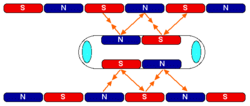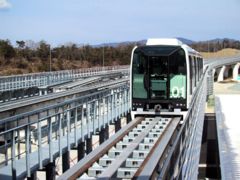Maglev train
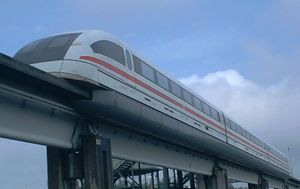
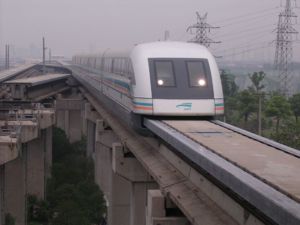
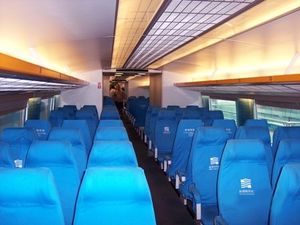
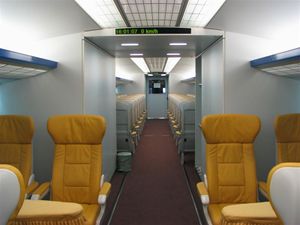
Magnetic levitation transport, or maglev, is a form of transportation that suspends, guides and propels vehicles via electromagnetic force. This method can be faster than wheeled mass transit systems, potentially reaching velocities comparable to turboprop and jet aircraft (500 to 580 km/h).
The world's first commercial application of a high-speed maglev line is the IOS (initial operating segment) demonstration line in Shanghai, China that transports people 30 km (18.6 miles) to the airport in just 7 minutes 20 seconds (top speed of 431 km/h or 268 mph, average speed 250 km/h or 150 mph). Other maglev projects worldwide are being studied for feasibility. However, scientific, economic and political barriers and limitations have hindered the widespread adoption of the technology.
All operational implementations of maglev technology have had minimal overlap with wheeled train technology and have not been compatible with conventional railroad tracks. Because they cannot share existing infrastructure, maglevs must be designed as complete transportation systems. The term "maglev" refers not only to the vehicles, but to the railway system as well, specifically designed for magnetic levitation and propulsion.
Contents
Technology
- See also fundamental technology elements in the JR-Maglev article
There are two primary types of maglev technology:
- electromagnetic suspension (EMS) uses the attractive magnetic force of a magnet beneath a rail to lift the train up.
- electrodynamic suspension (EDS) uses a repulsive force between two magnetic fields to push the train away from the rail.
Electromagnetic suspension
In current EMS systems, the train levitates above a steel rail while electromagnets, attached to the train, are oriented toward the rail from below. The electromagnets use feedback control to maintain a train at a constant distance from a track.
Electrodynamic suspension
In Electrodynamic suspension (EDS), both the rail and the train exert a magnetic field, and the train is levitated by the repulsive force between these magnetic fields. The magnetic field in the train is produced by either electromagnets (as in JR-Maglev) or by an array of permanent magnets (as in Inductrack). The repulsive force in the track is created by an induced magnetic field in wires or other conducting strips in the track.
At slow speeds, the current induced in these coils and the resultant magnetic flux is not large enough to support the weight of the train. For this reason the train must have wheels or some other form of landing gear to support the train until it reaches a speed that can sustain levitation.
Propulsion coils on the guideway are used to exert a force on the magnets in the train and make the train move forwards. The propulsion coils that exert a force on the train are effectively a linear motor: An alternating current flowing through the coils generates a continuously varying magnetic field that moves forward along the track. The frequency of the alternating current is synchronized to match the speed of the train. The offset between the field exerted by magnets on the train and the applied field create a force moving the train forward.
Pros and cons of different technologies
Each implementation of the magnetic levitation principle for train-type travel involves advantages and disadvantages. Time will tell as to which principle, and whose implementation, wins out commercially.
| Technology | Pros | Cons | ||||||||||||
| EMS (Electromagnetic) | Magnetic fields inside and outside the vehicle are insignificant; proven, commercially available technology that can attain very high speeds (500 km/h); no wheels or secondary propulsion system needed | The separation between the vehicle and the guideway must be constantly monitored and corrected by computer systems to avoid collision due to the unstable nature of electromagnetic attraction. | ||||||||||||
| Electromagnetic EDS (Electrodynamic) | Powerful onboard superconducting magnets and large margin between rail and train enable highest recorded train speeds (581 km/h) and heavy load capacity; has recently demonstrated (Dec 2005) successful operations using high temperature superconductors (HTS) in its onboard magnets, cooled with inexpensive liquid nitrogen | Strong magnetic fields onboard the train make the train inaccessible to passengers with pacemakers or magnetic data storage media such as hard drives and credit cards, necessitating the use of magnetic shielding; vehicle must be wheeled for travel at low speeds; system per mile cost still considered prohibitive; the system is not yet out of prototype phase. | ||||||||||||
| Inductrack System (Permanent Magnet EDS) | Failsafe Suspension - no power required to activate magnets; Magnetic field is localized below the car, can generate enough force at low speeds (around 5 km/h) to levitate maglev train; in case of power failure cars slow down on their own in a safe, steady and predictable manner before coming to a stop; Halbach arrays of permanent magnets may prove more cost-effective than electromagnets | Requires either wheels or track segments that move for when the vehicle is stopped. New technology that is still under development (as of 2006) and has as yet no commercial version or full scale system prototype. | ||||||||||||
Neither Inductrack nor the Superconducting EDS are able to levitate vehicles at a standstill, although Inductrack provides levitation down to a much lower speed. Wheels are required for both systems. EMS systems are wheel-less. The German Transrapid, Japanese HSST (Linimo), and Korean Rotem EMS maglevs levitate at a standstill, with electricity extracted from guideway using power rails for the latter two, and wirelessly for Transrapid. If guideway power is lost on the move, the Transrapid is still able to generate levitation down to 10 km/h speed, using the power from onboard batteries. This is not the case with the HSST and Rotem systems. PropulsionAn EMS system can provide both levitation and propulsion using an onboard linear motor. EDS systems can only levitate the train using the magnets onboard, not propel it forward. As such, vehicles need some other technology for propulsion. A linear motor (propulsion coils) mounted in the track is one solution. Over long distances where the cost of propulsion coils could be prohibitive, a propeller or jet engine could be used. StabilityStatic magnetic bearings using only electromagnets and permagnets are unstable, as explained by Earnshaw's theorem. EMS systems rely on active electronic stabilization. Such systems constantly measure the bearing distance and adjust the electromagnet current accordingly. As all EDS systems are moving systems (i.e. no EDS system can levitate the train unless it is in motion), Earnshaw's theorem does not apply to them. Pros and cons of maglev vs. conventional trainsDue to the lack of physical contact between the track and the vehicle, there is no rolling friction, leaving only air resistance (although maglev trains also experience electromagnetic drag, this is relatively small at high speeds). [1] Maglevs can handle high volumes of passengers per hour (comparable to airports or eight-lane highways) and do it without introducing air pollution along the right of way. Of course, the electricity has to be generated somewhere, so the overall environmental impact of a maglev system is dependent on the nature of the grid power source. The weight of the large electromagnets in EMS and EDS designs are a major design issue. A very strong magnetic field is required to levitate a massive train. For this reason one research path is using superconductors to improve the efficiency of the electromagnets. Due to its high speed and shape, the noise generated by a maglev train is similar to a jet aircraft, and is considerably more disturbing than standard steel on steel intercity train noise. A study found the difference between disturbance levels of maglev and traditional trains to be 5dB (about 78% noisier).[2] EconomicsThe Shanghai maglev cost 9.93 billion yuan (US$1.2 billion) to build.[3] This total includes infrastructure capital costs such as manufacturing and construction facilities, and operational training. At 50 yuan per passenger[4] and the current 7,000 passengers per day, income from the system is incapable of recouping the capital costs (including interest on financing) over the expected lifetime of the system, even ignoring operating costs. China aims to limit the cost of future construction extending the maglev line to approximately 200 million yuan (US$24.6 million) per kilometer.[3] These costs compare competitively with airport construction (e.g., Hong Kong Airport cost US$20 billion to build in 1998) and eight-lane Interstate highway systems that cost around US$50 million per mile in the US. While high-speed maglevs are expensive to build, they are less expensive to operate and maintain than traditional high-speed trains, planes or intercity buses. Data from the Shanghai maglev project indicates that operation and maintenance costs are covered by the current relatively low volume of 7,000 passengers per day. Passenger volumes on the Pudong International Airport line are expected to rise dramatically once the line is extended from Longyang Road metro station all the way to Shanghai's downtown train depot. The proposed Chūō Shinkansen line is estimated to cost approximately US$82 billion to build. The only low-speed maglev (100 km/h) currently operational, the Japanese Linimo HSST, cost approximately US$100 million/km to build[5]. Besides offering improved O&M costs over other transit systems, these low-speed maglevs provide ultra-high levels of operational reliability and introduce little noise and zero air pollution into dense urban settings. As maglev systems are deployed around the world, experts expect construction costs to drop as new construction methods are perfected.[citation needed] Historical maglev systemsOriginal patent (1941)The first patent for a magnetic levitation train propelled by linear motors was German Patent 707032, issued in June 1941. A U.S. patent, dated 1 October 1907, is for a linear motor propelled train in which the motor, below the steel track, carried some but not all of the weight of the train. The inventor was Alfred Zehden of Frankfurt-am-Main. Birmingham 1984–1995The world's first commercial automated system was a low-speed maglev shuttle that ran from the airport terminal of Birmingham International Airport (UK) to the nearby Birmingham International railway station from 1984 to 1995. Based on experimental work commissioned by the British government at the British Rail Research Division laboratory at Derby, the length of the track was 600 m, and trains "flew" at an altitude of 15 mm. It was in operation for nearly eleven years, but obsolescence problems with the electronic systems made it unreliable in its later years and it has now been replaced with a cable-drawn system. Several favourable conditions existed when the link was built. (1)The BR Research vehicle was 3 tons and extension to the 8 ton vehicle was easy. (2) Electrical power was easily available. (3) Airport and rail buildings were suitable for terminal platforms. (4) Only one crossing over a pblic road was required and no steep gradients were involved (5) Land was owned by Railway or Airport (6) Local industries and councils were supportive (7) Some Govenment finance was provided and because of sharing work, the cost per organisation was not high. Berlin 1989–1991In West Berlin, the M-Bahn was built in the late 1980s. It was a driverless maglev system with a 1.6 km track connecting three stations. Testing in passenger traffic started in August 1989, and regular operation started in July 1991. Although the line largely followed a new elevated alignment, it terminated at the U-Bahn station Gleisdreieck, where it took over a platform that was then no longer in use; it was from a line that formerly ran to East Berlin. After the fall of the Berlin Wall, plans were set in motion to reconnect this line (today's U2). Deconstruction of the M-Bahn line began only two months after regular service began and was completed in February 1992. Existing maglev systems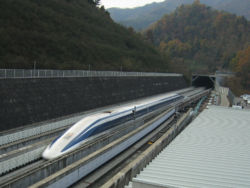 JR-Maglev at Yamanashi Emsland, GermanyTransrapid, a German maglev company, has a test track in Emsland with a total length of 31.5 km. JR-MaglevJapan has a demonstration line in Yamanashi prefecture where test trains JR-Maglev MLX01 have reached 581 km/h (361 mph), faster than any wheeled trains. These trains use superconducting magnets which allow for a larger gap, and repulsive-type Electro-Dynamic Suspension (EDS). In comparison Transrapid uses conventional electromagnets and attractive-type Electro-Magnetic Suspension (EMS). These "Superconducting Maglev Shinkansen", developed by the Central Japan Railway Co. ("JR Central") and Kawasaki Heavy Industries, are currently the fastest trains in the world, achieving a record speed of 581 km/h on December 2, 2003. Yamanashi Prefecture residents (and government officials) can sign up to ride this for free, and some 100,000 have done so already. Linimo (Tobu Kyuryo Line)The world's first commercial automated "Urban Maglev" system commenced operation in March 2005 in Aichi, Japan. This is the nine-station 8.9 km long Tobu-kyuryo Line, otherwise known as the Linimo. The line has a minimum operating radius of 75 m and a maximum gradient of 6%. The linear-motor magnetic-levitated train has a top speed of 100 km/h. The line serves the local community as well as the Expo 2005 fair site. The trains were designed by the Chūbu HSST Development Corporation, which also operates a test track in Nagoya. Urban-type maglevs patterned after the HSST have been constructed and demonstrated in Korea, and a Korean commercial version Rotem is now under construction in Daejeon and projected to go into operation by April of 2007. FTA's UMTD programIn the US, the Federal Transit Administration (FTA) Urban Maglev Technology Demonstration program has funded the design of several low-speed urban maglev demonstration projects. It has assessed HSST for the Maryland Department of Transportation and maglev technology for the Colorado Department of Transportation. The FTA has also funded work by General Atomics at California University of Pennsylvania to demonstrate new maglev designs, the MagneMotion M3 and of the Maglev2000 of Florida superconducting EDS system. Other US urban maglev demonstration projects of note are the LEVX in Washington State and the Massachusetts-based Magplane. Southwest Jiaotong University, ChinaOn December 31, 2000, the first crewed high-temperature superconducting maglev was tested successfully at Southwest Jiaotong University, Chengdu, China. This system is based on the principle that bulk high-temperature superconductors can be levitated or suspended stably above or below a permanent magnet. The load was over 530 kg and the levitation gap over 20 mm. The system uses liquid nitrogen, which is very cheap, to cool the superconductor. Shanghai Maglev TrainContructed from 2000-2004,it links the Pudong Airport and Shanghai Metro, it is based on the maglev technologies of Siemens. Under constructionOld Dominion UniversityA track of less than a mile in length has been constructed at Old Dominion University in Norfolk, Virginia. Although the system was initially built by AMT, problems caused the company to abandon the project and turn it over to the University.[6][7] The system is currently not operational, but research is ongoing to resolve stability issues with the system. This system uses a "smart train, dumb track" that involves most of the sensors, magnets, and computation occurring on the train rather than the track. This system will cost less to build per mile than existing systems. AMT Test Track - Powder Springs, GAThe same principle is involved in the construction of a second prototype system in Powder Springs, Georgia, by American Maglev Technology, Inc., already under testing and set for completion in January 2007.[8] ProposalsEuropeUnited KingdomLondon - Glasgow A maglev line has recently been proposed in the United Kingdom from London to Glasgow with several route options through the Midlands, Northwest and Northeast of England and is reported to be under favourable consideration by the government. A further high speed link is also being planned between Glasgow to Edinburgh though there is no settled technology for this concept yet, ie (Maglev/Hi Speed Electric etc) [6] [7] [8] Glasgow - Edinburgh A separate maglev link is also being planned between Glasgow airport and Glasgow to Edinburgh airport and Edinburgh which would cut journey time between the two cities from one hour to 15 minutes. Work will begin as early as January 2008. The technology that will used has not be decided. [9] GermanyMunich A Transrapid connection of the Bavarian capital Munich to its international airport (37 km) is now being planned. It would reduce the current connection time via S-Bahn (German city railroad system) from about 40 minutes to 10 minutes. Berlin - Hamburg A 292 km Transrapid line linking Berlin to Hamburg. It has been cancelled due to lack of funds. Instead the existing railway line has been upgraded to 230 km/h for ICE train sets. AsiaJapanTokyo - Osaka If a proposed Chūō Shinkansen is built, connecting Tokyo to Osaka by maglev, the existing test track in Yamanashi prefecture would be part of the line. ChinaShanghai - Hangzhou China has decided to build a second Transrapid maglev rail with a length of 160 km from Shanghai to Hangzhou (Shanghai-Hangzhou maglev line). Talks with Germany and Transrapid Konsortium about the details of the construction contracts have started. On March 7 2006, the Chinese Minister of Transportation was quoted by several Chinese and Western newspapers as saying the line was approved. Construction will probably start towards the end of 2006 and is scheduled to be completed in time for the 2010 Shanghai Expo, becoming the first inter-city Maglev rail line in commercial service in the world. The line will be an extension of the Shanghai airport Maglev line. MalaysiaJohor Malaysia has decided to use Mag-lev technology to link important landmarks across the city. This will be a boost to business to compete against the neighbouring city, Singapore. USALos Angeles, Southern California - Las Vegas High-speed maglev lines between major cities of southern California and Las Vegas are also being studied via the California-Nevada Interstate Maglev Project. This plan was originally supposed to be part of an I-5 or I-15 expansion plan, but the federal government has ruled it must be separated from interstate work projects. Since the federal government decision, private groups from Nevada have proposed a line running from Las Vegas to Los Angeles with stops in Primm, Nevada; Baker, California; and points throughout Riverside County into Los Angeles. Southern California politicians have not been receptive to these proposals; many are concerned that a high speed rail line out of state would drive out dollars that would be spent in state "on a rail" to Nevada. Baltimore - Washington, D.C. A 64 km project has been proposed linking Camden Yards in Baltimore and Baltimore-Washington International (BWI) Airport to Union Station in Washington, D.C. It is in demand for the area due to its current traffic/congestion problems. The project is in contention for the same federal grant as the Pittsburgh project. Honolulu The city of Honolulu, Hawaii is said to be planning a Linimo class urban Maglev for its main mass transit train. [citation needed] San Diego San Diego is considering a high-speed maglev line to serve as a passenger transportation node to remote airport sites under consideration. The cost estimate is approximately $10 billion U.S. for the 120-150 km (80-100 mile) run, not including the cost of construction of the airport. [10] The Cascadia Maglev Long-proposed but not on any official drawing boards would be a Maglev line along the Interstate 5 corridor, its core component from Portland, Oregon to Vancouver, British Columbia, with eventual extensions to Eugene, Oregon (in the south) and Whistler, British Columbia (in the north). The initial phase of the project would link Tacoma to Seattle, mirroring the old interurban line between those two cities. The same idea has re-surfaced with a conventional high-speed rail proposal, although its extension into British Columbia has been largely blocked by opposition on the part of the City of White Rock, British Columbia, which would sit astride the line. VactrainMaglev ground speed is capped by aerodynamic drag and noise limitations. The use of evacuated tunnels (i.e. a partial vacuum) similar to the external air pressure of air travel at 40,000 feet could boost travel speeds for Maglev's to 5,000 mph (8,000 km/h). As early as 1973, a RAND study concluded that future high-performance maglev systems built with advanced tunneling and control technologies, could form the backbone of a true global "subway system".[9]. Theoretically, these tunnels could be built deep enough to pass under oceans or to use gravity to assist the trains' acceleration. This would likely be prohibitively costly without major advances in tunnelling technology. Alternatives such as elevated concrete tubes with partial vacuums have been proposed to reduce these costs. If the trains topped out at around 8000 km/h (5000 mph), the 5567km trip between London and New York would take a short 54 minutes, effectively supplanting aircraft as the world's fastest mode of public transportation. UniModalUniModal is a personal rapid transit idea that proposes to use Inductrack suspension to achieve speeds of 160 km/h (100 mph). Most significant accidents and incidentsAugust 11, 2006 fireOn August 11, 2006 a fire broke out on the Shanghai commercial Transrapid, shortly after leaving the terminal in Longyang.
September 22, 2006 crashOn September 22, 2006 an elevated Transrapid train collided with a maintenance vehicle on a test run in Lathen (Lower Saxony / north-western Germany). Twenty-three people were killed and ten were injured. These were the first fatalities resulting from a Maglev train accident. Notes
References
See also
External linksResearch and Government
Transrapid
Linear motor car
LinimoMaglev train companiesThese websites contain further information provided by companies building maglev trains (alphabetical order).
Info, Media and other
|
||||||||||||||
